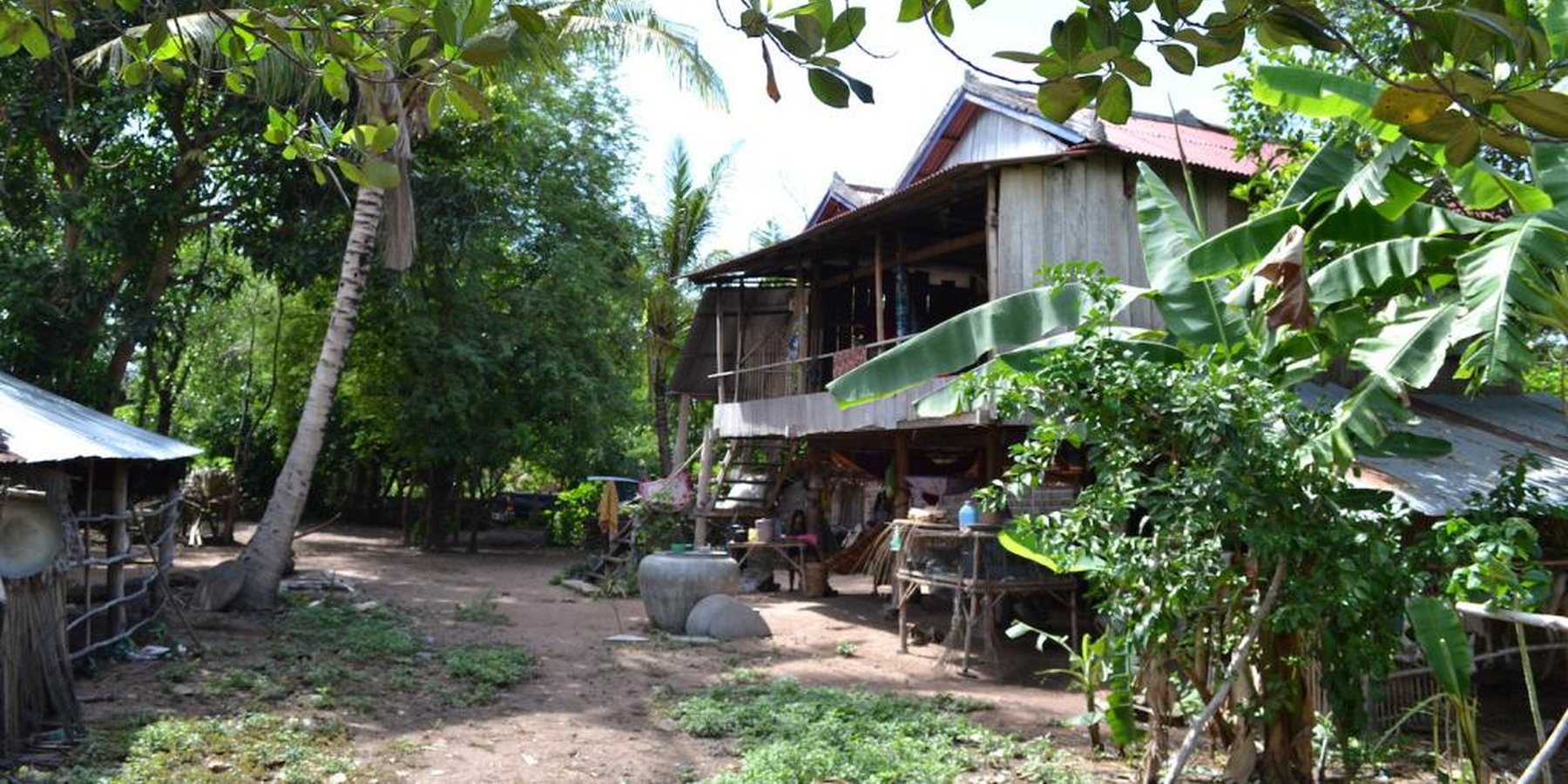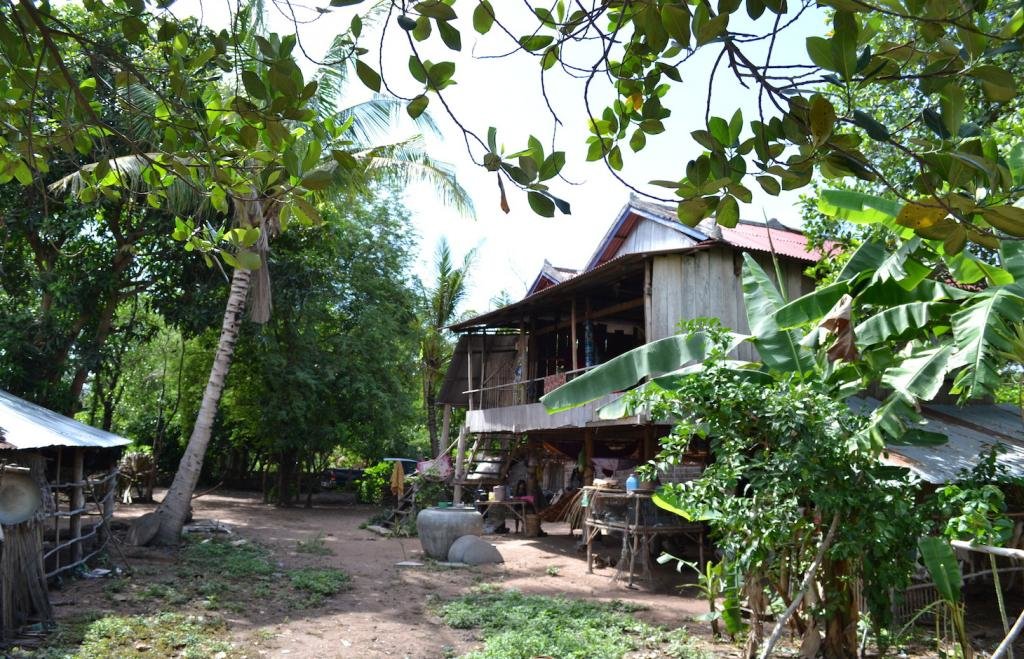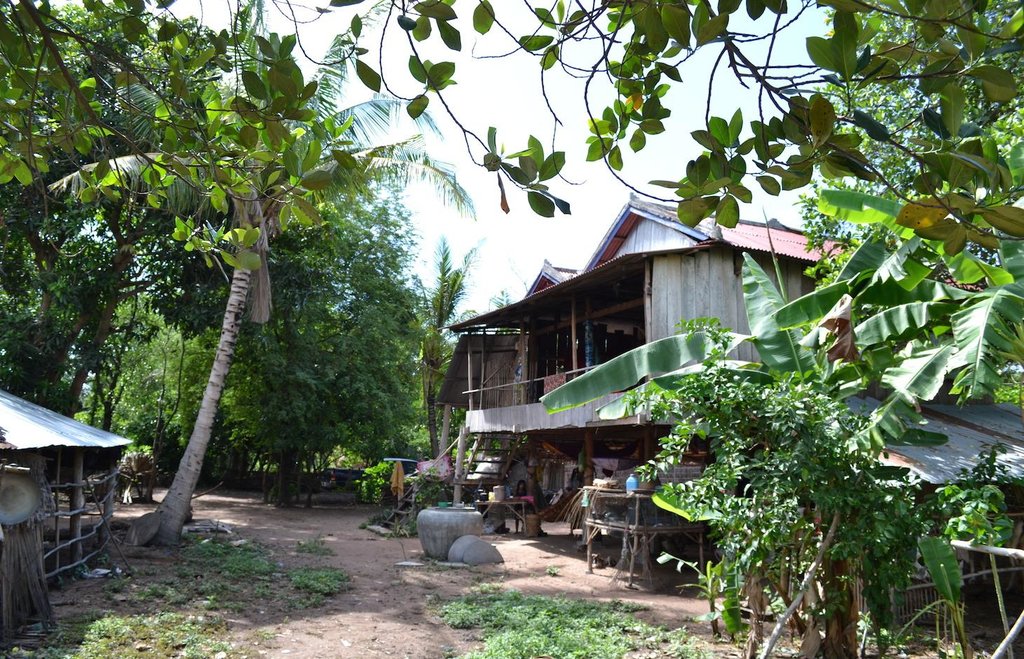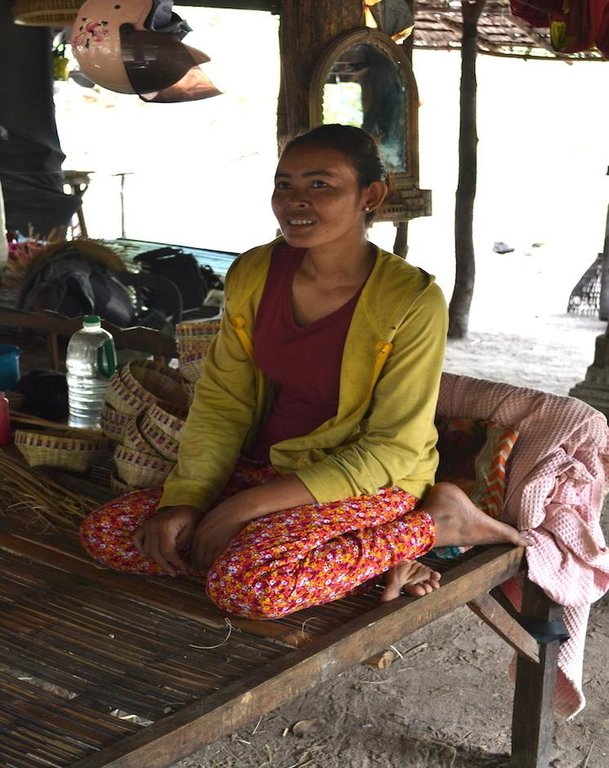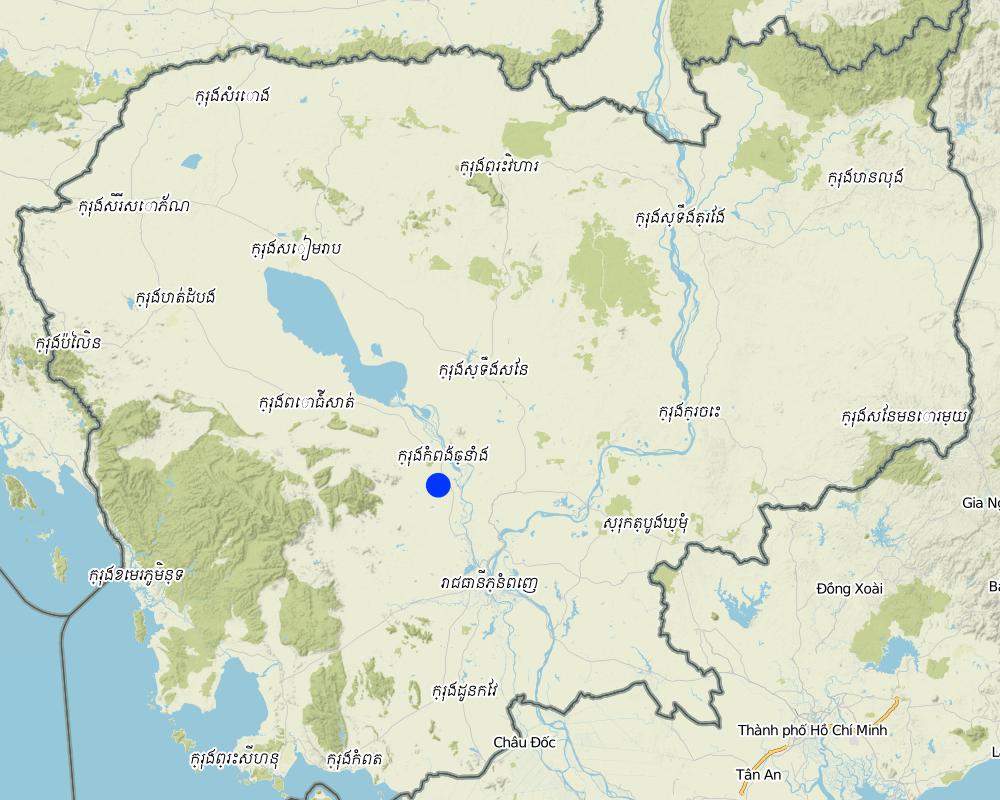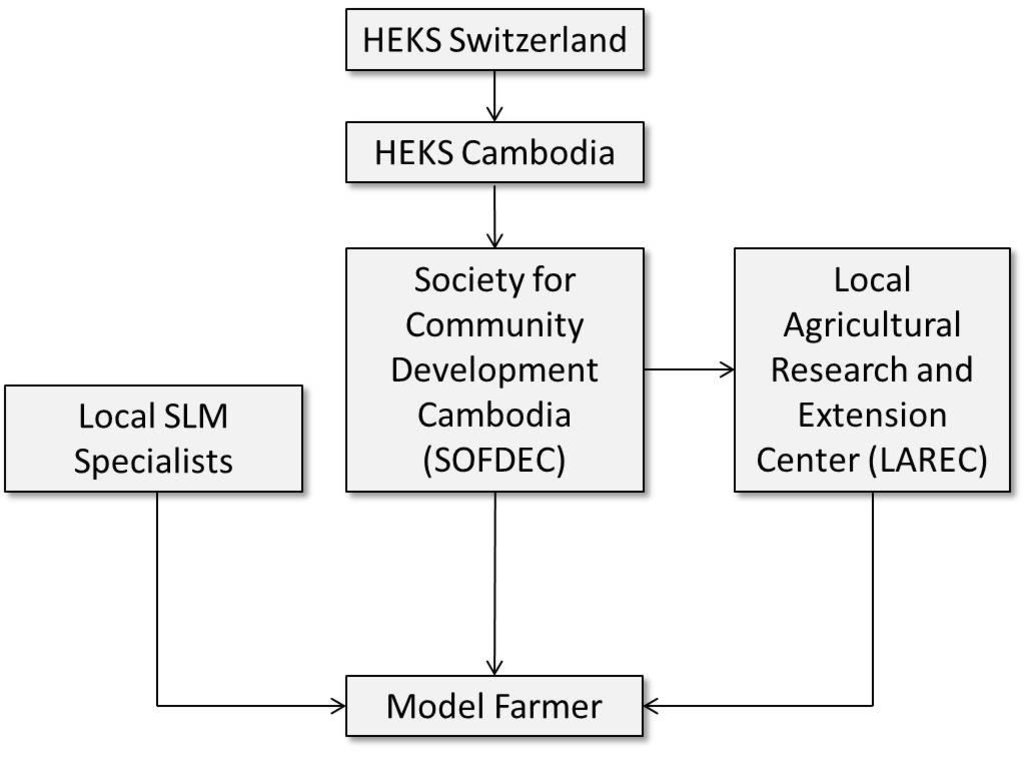Model farmer [ប្រទេសកម្ពុជា]
- ការបង្កើត៖
- បច្ចុប្បន្នភាព
- អ្នកចងក្រង៖ Christoph Kaufmann
- អ្នកកែសម្រួល៖ –
- អ្នកត្រួតពិនិត្យ David Streiff
approaches_2498 - ប្រទេសកម្ពុជា
ពិនិត្យមើលគ្រប់ផ្នែក
ពង្រីកមើលទាំងអស់ បង្រួមទាំងអស់1. ព័ត៌មានទូទៅ
1.2 ព័ត៌មានលម្អិតពីបុគ្គលសំខាន់ៗ និងស្ថាប័នដែលចូលរួមក្នុងការវាយតម្លៃ និងចងក្រងឯកសារនៃវិធីសាស្ត្រផ្សព្វផ្សាយ
អ្នកជំនាញឯកទេស SLM:
អ្នកជំនាញឯកទេស SLM:
Say Mesa
Society for Community Development in Cambodia
ប្រទេសកម្ពុជា
អ្នកជំនាញឯកទេស SLM:
Bin Sreytouch
Society for Community Development in Cambodia
ប្រទេសកម្ពុជា
អ្នកជំនាញឯកទេស SLM:
Khun Lean Hak
SOFDEC/LAREC
ឈ្មោះអង្គភាពមួយ (ច្រើន) ដែលបានចងក្រងឯកសារ/ វាយតម្លៃលើវិធីសាស្ត្រផ្សព្វផ្សាយ (បើទាក់ទង)
Local Agricultural Research and Extension Centre (LAREC) - ប្រទេសកម្ពុជាឈ្មោះអង្គភាពមួយ (ច្រើន) ដែលបានចងក្រងឯកសារ/ វាយតម្លៃលើវិធីសាស្ត្រផ្សព្វផ្សាយ (បើទាក់ទង)
Society for Community Development in Cambodia (SOFDEC) - ប្រទេសកម្ពុជាឈ្មោះអង្គភាពមួយ (ច្រើន) ដែលបានចងក្រងឯកសារ/ វាយតម្លៃលើវិធីសាស្ត្រផ្សព្វផ្សាយ (បើទាក់ទង)
CDE Centre for Development and Environment (CDE Centre for Development and Environment) - ប្រទេសស្វ៊ីស1.3 លក្ខខណ្ឌទាក់ទងទៅនឹងការប្រើប្រាស់ទិន្នន័យដែលបានចងក្រងតាមរយៈវ៉ូខេត
តើពេលណាដែលទិន្នន័យបានចងក្រង (នៅទីវាល)?
25/06/2014
អ្នកចងក្រង និង(បុគ្គលសំខាន់ៗ)យល់ព្រមទទួលយកនូវលក្ខខណ្ឌនានាទាក់ទងទៅនឹងការប្រើប្រាស់ទិន្នន័យដែលបានចងក្រងតាមរយៈ វ៉ូខេត:
បាទ/ចា៎
1.4 ការយោងមួយ (ច្រើន) ទៅលើ (កម្រង) បញ្ជីសំណួរនៃបច្ចេកទេស SLM
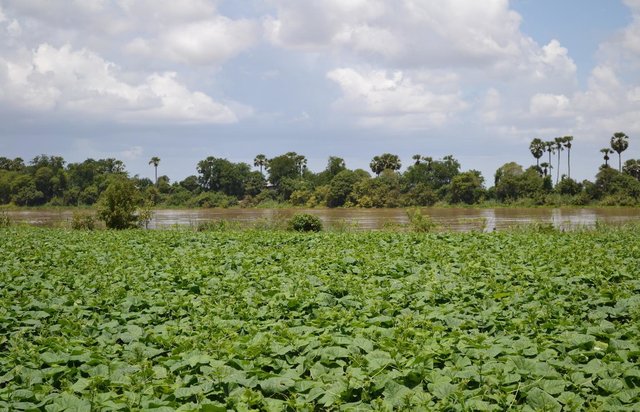
Mulching with water hyacinth (Eichhornia crassipes) after the … [ប្រទេសកម្ពុជា]
Water hyacinth (Eichhornia crassipes) is collected during the monsoon floods, attached to poles on the flooded fields, chopped when the water recedes and used as mulch to plant different crops.
- អ្នកចងក្រង៖ Christoph Kaufmann
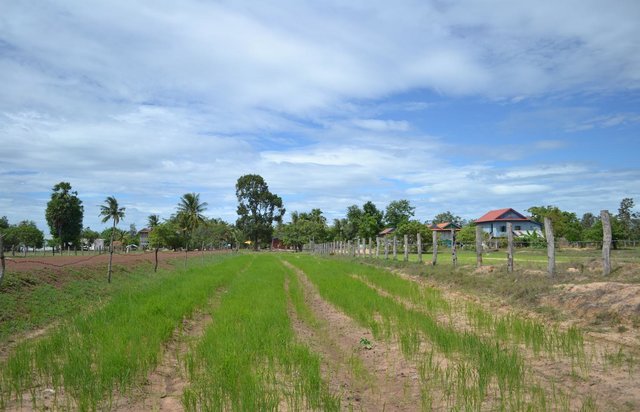
Adapted System of Rice Intensification (SRI) principles in … [ប្រទេសកម្ពុជា]
Some points of the System of Rice Intensification (SRI) technology, like the row transplanting of young seedlings and the use of compost are adapted and applied in Kampong Chhnang.
- អ្នកចងក្រង៖ Christoph Kaufmann
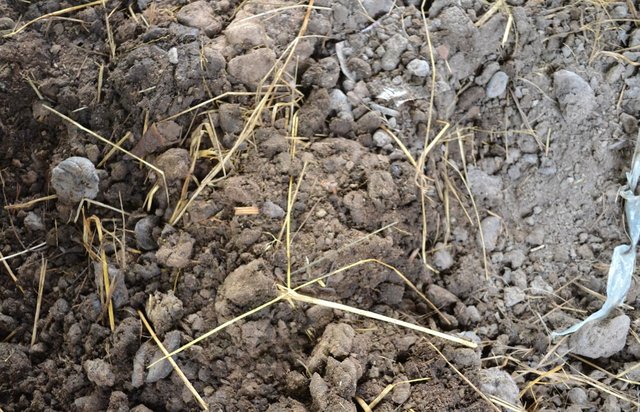
Compost application on rice fields [ប្រទេសកម្ពុជា]
Manure, leaves and rice straw are gathered in a compost house and the produced compost is applied twice a year to the rice field.
- អ្នកចងក្រង៖ Christoph Kaufmann
2. ការពណ៌នាអំពីវិធីសាស្ត្រផ្សព្វផ្សាយ SLM
2.1 ពណ៌នាសង្ខេបខ្លីពីវិធីសាស្ត្រផ្សព្វផ្សាយ
Model farms were introduced by a NGO in order to spread knowledge about SLM (compost, System of Rice Intensification SRI, and other technologies) in the project area.
2.2 ពណ៌នាលម្អិតពិវិធីសាស្ត្រផ្សព្វផ្សាយ
ពណ៌នាលម្អិតពិវិធីសាស្ត្រផ្សព្វផ្សាយ:
Aims / objectives: Model farms were introduced to Kampong Chhnang Province in order to spread knowledge about SLM Technologies.
Methods: The Approach focuses on various areas of farming, and the model farms are clustered into 4 groups:
1. Compost and System of Rice Intensification focus on rice productivity and soil improvement.
2. SLT (Seasonal Long Training) – growing techniques for different crops, seedling germination, care taking, harvesting, etc.
3. INTEREST – focus on different crops which are mixed, crop rotation (rice-watermelon-corn, e.g.), mulching, cover cropping.
4. Cow raising model farmers – focus on fodder production, vaccination, supplementary feed for the cows, stable construction.
In this case study, the model farmer applies the System of Rice Intensification (SRI) and compost (cluster 1).
Stages of implementation: Becoming a model farmer consists of different steps. First, different land users who dispose of the required inputs (certain amount of land, labour availability, motivation for innovation) are invited to a training organized by a local NGO. After the training, the model farmers are chosen amongst the participating land users. These newly elected model farmers get further training from the NGO. While implementing the selected Technologies (in this case SRI and compost), the model farmers are subsidized and monitored by the NGO.
Role of stakeholders: The role of the stakeholders is both active and passive. While they are invited to the initial training provided by the local NGO (passive), the land users decide - once they're selected as model farmers - by themselves which Technologies they want to apply on their fields (active).
Other important information: The benefits of this Approach are manifold. Firstly, it helps spreading knowledge about sustainable land management in the project area. In the case of Cambodia this is especially important since much of the agricultural knowledge was lost during the Khmer Rouge regime (1975-1979). Furthermore, the soils in the project area are sandy and show a low fertility. Therefore for example compost making can have a positive long term impact on both the natural and the human wellbeing. Secondly, model farmers can have a positive impact on local institutions. It is for example possible for the farmers to give a report to local authorities where they state what the villagers need most. Furthermore, model farmers can become members of NGOs or local authorities, or monitor other farmers in their activities.
The main disadvantage of the Approach is the problem of sustainability. Model farmers are in close cooperation with the local NGO, and if the NGO stops the coaching, it is not ensured that the implemented Technologies will continue. This is illustrated by many abandoned compost houses in the area. Also, the interviewed model famer expressed that since she became a model farmer, there is more work to do. This can be detrimental in an environment where a high migration rate decreases the available labour force. Last but not least the decision about which Technologies are to be applied on the given model farms are mainly taken by the SLM specialists working for the local NGO. If land users were more involved in the decision-making process, this might have a positive long term impact on the farmers motivation to continue applying the chosen Technologies independently (sustainability).
2.3 រូបភាពនៃវិធីសាស្ត្រផ្សព្វផ្សាយ
2.5 ប្រទេស/តំបន់/ទីតាំងកន្លែង ដែលវិធីសាស្ត្រផ្សព្វផ្សាយត្រូវបានអនុវត្តន៍
ប្រទេស:
ប្រទេសកម្ពុជា
តំបន់/រដ្ឋ/ខេត្ត:
Kampong Chhnang
បញ្ជាក់បន្ថែមពីលក្ខណៈនៃទីតាំង:
Rolear Pha-er
មតិយោបល់:
For one model farmer, there are approximately 5 other farmers who copy the technologies
Map
×2.6 កាលបរិច្ឆេទនៃការចាប់ផ្តើម និងបញ្ចប់នៃវិធីសាស្រ្តផ្សព្វផ្សាយនេះ
សូមបញ្ជាក់ឆ្នាំដែលបានបង្កើតឡើង:
2006
2.7 ប្រភេទនៃវិធីសាស្ត្រផ្សព្វផ្សាយ
- ផ្អែកលើគម្រោង/កម្មវិធី
2.8 គោលបំណង/ទិសដៅសំខាន់នៃវិធីសាស្ត្រផ្សព្វផ្សាយ
The Approach focused on SLM only
On one hand, land users learn about new technologies (e.g. compost, SRI) which have a positive impact on the yields, the soil fertility and in consequence on the income. On the other hand, model farmers are enabled to show these technologies to other land users (knowledge sharing) so these technologies can be spread in the area. One way to share the knowledge are farmer field days where other land users visit the model farms.
The SLM Approach addressed the following problems: Lack of technical knowledge, low agricultural production, low soil fertility.
2.9 លក្ខខណ្ឌអនុញ្ញាត ឬរារាំងការអនុវត្តន៍បច្ចេកទេសដែលស្ថិតនៅក្រោមវិធីសាស្រ្តផ្សព្វផ្សាយ
ក្របខណ្ឌច្បាប់ (សិទ្ធិកាន់កាប់ដីធ្លី កម្មសិទ្ធីប្រើប្រាស់ដីនិងទឹក)
- អំណោយផល
The current situation of land use rights and ownership is rather complicated since there are different perceptions coexisting. Therefore, no concluding statement about the influence of this situation on the implementation of model farms can be made.
- រារាំង
The process of formalizing land use rights in Cambodia is slow. No relationship between this Approach and land use rights.
ចំណេះដឹងស្តីពី SLM និងការទទួលបានការគាំទ្រផ្នែកបច្ចេកទេស
- រារាំង
Other farmers did not have technical knowledge about the technologies
Treatment through the SLM Approach: Farmers could learn from the model farmer, monitoring can help to maintain the best practices.
3. ការចូលរួម និងតួនាទីរបស់ភាគីពាក់ព័ន្ធ
3.1 អ្នកពាក់ព័ន្ធដែលបានចូលរួមក្នុងវិធីសាស្ត្រផ្សព្វផ្សាយ និងតួនាទីរបស់ពួកគេ
- អ្នកប្រើប្រាស់ដីក្នុងតំបន់/សហគមន៍
Model farms were installed on existing farms.
The involvement of socially and economically disadvantaged group is indirect. They are not selected as model farmers since they don’t have the necessary inputs. However they can benefit from farmer field days or from talking to a model farmer in order to learn about the new technologies.
- អ្នកឯកទេសគ្រប់គ្រងដីប្រកបដោយចីរភាព/ទីប្រឹក្សាបច្ចេកទេសកសិកម្ម
- អង្គការក្រៅរដ្ឋាភិបាល
Society for Community Development in Cambodia SOFDEC
- រដ្ឋាភិបាលថ្នាក់មូលដ្ឋាន
The Provincial Department of Agriculture PDA was informed about the approach by SOFDEC.
- រដ្ឋាភិបាលថ្នាក់ជាតិ (អ្នករៀបចំផែនការ អ្នកសម្រេចចិត្ត)
At local level, passive
3.2 ការចូលរួមរបស់អ្នកប្រើប្រាស់ដីក្នុងតំបន់/ សហគមន៍ក្នុងតំបន់ក្នុងដំណាក់កាលផ្សេងគ្នានៃវិធីសាស្រ្តផ្សព្វផ្សាយ
| ការចូលរួមរបស់អ្នកប្រើប្រាស់ដីក្នុងតំបន់/សហគមន៍ក្នុងតំបន់ | សូមបញ្ជាក់នរណាត្រូវបានចូលរួម ព្រមទាំងពណ៌នាសកម្មភាពទាំងនោះ | |
|---|---|---|
| ការចាប់ផ្តើម/ការលើកទឹកចិត្ត | អសកម្ម | The land user attended a workshop organized by SOFDEC/LAREC where he was selected as model farmer. This workshop took place more than 10 years ago. |
| ការរៀបចំផែនការ | អន្តរកម្ម | Farmer plans implementation of compost and SRI |
| ការអនុវត្តន៍ | ការគាំទ្រពីខាងក្រៅ | Money from SOFDEC for compost, 15 USD (in-kind contribution by farmer, e.g. labour, some material (wooden pole) and own money to buy cement, iron roof). Training for compost and SRI. SRI field day. |
| ការត្រួតពិនិត្យ និងវាយតម្លៃ | អសកម្ម | Coaching by SOFDEC |
| Research | គ្មាន | Research is carried out by LAREC and the results, such as new rice varieties, and brought to the model farmer by SOFDEC. |
3.3 គំនូសបំព្រួញ (ប្រសិនបើមាន)
ការពណ៌នា:
HEKS Switzerland funded the Society for Community Development in Cambodia (SOFDEC), and they support this organisation financially. SOFDEC then funded a research centre on sustainable land management and crops (LAREC) which also maintains an extension service. Together with other local SLM specialists, SOFDEC initiated model farms.
អ្នកនិពន្ធ:
Stefan Graf (Centre for Development and Environment)
3.4 ការសម្រេចចិត្តលើការជ្រើសរើសបច្ចេកទេស SLM
សូមបញ្ជាក់តើអ្នកណាជាអ្នកបានសម្រេចចិត្តក្នុងការជ្រើសរើសបច្ចេកទេសដើម្បីយកមកអនុវត្តន៍:
- អ្នកជំនាញឯកទេស SLM បន្ទាប់ពីបានប្រឹក្សាយោបល់ជាមួយអ្នកប្រើប្រាស់ដី
ចូរពន្យល់:
Decisions on the method of implementing the SLM Technology were made by mainly by SLM specialists with consultation of land users
4. ជំនួយបច្ចេកទេស ការកសាងសមត្ថភាព និងការគ្រប់គ្រងចំណេះដឹង
4.1 ការកសាងសមត្ថភាព/ បណ្តុះបណ្តាល
តើវគ្គបណ្តុះបណ្តាលបានផ្តល់ឱ្យអ្នកប្រើប្រាស់ដី/អ្នកពាក់ព័ន្ធផ្សេងៗទៀតដែរឬទេ?
បាទ/ចា៎
សូមបញ្ជាក់តើអ្នកណាត្រូវបានបណ្តុះបណ្តាល:
- អ្នកប្រើប្រាស់ដី
ទម្រង់នៃការបណ្តុះបណ្តាល:
- អនុវត្តន៍ជាមួយការងារ
- វគ្គបណ្តុះបណ្តាល
ប្រធានបទបណ្តុះបណ្តាល:
compost making and on the different steps necessary to implement SRI. The training included both theoretical seminars and on-the-job training.
4.2 សេវាផ្តល់ប្រឹក្សាយោបល់
តើអ្នកប្រើប្រាស់ដីបានទទួលនូវសេវាផ្តល់ប្រឹក្សាដែរ ឬទេ?
បាទ/ចា៎
សូមបញ្ជាក់ប្រសិនបើសេវាកម្មប្រឹក្សាយោបល់ត្រូវបានផ្តល់ឱ្យ:
- នៅលើដីរបស់អ្នកប្រើប្រាស់ដី
ពណ៌នា/ពន្យល់:
Name of method used for advisory service: Advisory service; Key elements: The Provincial Department of Agriculture delivers some trainings to the farmers in collaboration with SOFDEC , SLM specialists from SOFDEC can get data from the Provincial Department of Agriculture
Advisory service is quite adequate to ensure the continuation of land conservation activities; The involvement of the Provincial Department of Agriculture is supplementary to SOFDEC’s work. Therefore, the land conservation activities could also continue without this advisory service.
4.3 ការពង្រឹងសមត្ថភាពស្ថាប័ន (ការអភិរឌ្ឍន៍អង្គភាព)
តើស្ថាប័នទាំងអស់ត្រូវបានបង្កើតឡើង ឬពង្រឹងសមត្ថភាពតាមរយៈវិធីសាស្ត្រផ្សព្វផ្សាយដែរ ឬទេ?
- បាទ/ច៎ា ជាមធ្យម
សូមបញ្ជាក់ថាតើស្ថាប័នត្រូវបានពង្រឹង ឬបង្កើតឡើងនៅត្រឹមកម្រិតណា(ច្រើន)?
- ថ្នាក់មូលដ្ឋាន
សូមបញ្ជាក់ប្រភេទនៃការគាំទ្រ:
- ការកសាងសមត្ថភាព/ បណ្តុះបណ្តាល
- decision making
សូមផ្តល់ព័ត៌មានបន្ថែមទៀតឱ្យបានលម្អិត:
It is possible that model farmers are enabled to influence local institutions through different ways. One possibility is that model farmers can give a report to the village chief and he can give the data to the commune chief. This is a way how the model farmer might influence the decision making within the village. Also, a model farmer can prepare a proposal to the commune chief where he states what the land users need the most (e.g. seeds).
The model farmers can also become facilitators for training other land users on new SLM technologies. Furthermore, the model farmers might be approached by other NGOs or projects to deliver trainings for them, or they might become members of local institutions such as the community council, or join a NGO. It is also possible for model farmers to take part in competitions organized either by NGOs (such as the Excellent Farmer Award) or the Provincial Department of Agriculture.
4.4 ការត្រួតពិនិត្យ និងវាយតម្លៃ
តើការត្រួតពិនិត្យ និងវាយតម្លៃគឺជាផ្នែកមួយនៃវិធីសាស្ត្រដែរឬទេ?
បាទ/ចា៎
មតិយោបល់:
Technical aspects were regular monitored by project staff, land users through observations; indicators: Training about how to do the Technology (for SRI and compost only once). Changes in the Technology, challenges for applying the Technology.
Economic / production aspects were regular monitored by project staff through measurements; indicators: Yields. SRI: Tillers per plant on 1 m2.
Management of Approach aspects were regular monitored by project staff through observations; indicators: SOFDEC trains the farmers how they can monitor other farmers.
There were no changes in the Approach as a result of monitoring and evaluation
There were few changes in the Technology as a result of monitoring and evaluation: Some Technologies, such as SRI, have been changed considerably since they have first been implemented. However, these changes were not done because of the monitoring, but because of other factors (lack of labour availability, feasibility, etc.).
4.5 ការស្រាវជ្រាវ
តើការស្រាវជ្រាវ គឺជាផ្នែកមួយនៃវិធីសាស្រ្តដែរឬទេ?
បាទ/ចា៎
បញ្ជាក់ប្រធានបទ:
- បច្ចេកវិទ្យា
សូមផ្តល់ព័ត៌មានបន្ថែមទៀតឱ្យបានលម្អិត និងចង្អុលបង្ហាញនរណាដែលបានធ្វើការស្រាវជ្រាវ:
Research is carried out by the Local Agriculture Research and Extension Centre LAREC. LAREC focus their research on different rice varieties (drought resistant, short breeding), and other plants which could be grown in the area (e.g. mung bean, pumpkin, water melon, stylo grass, etc.). The research is influenced by the demands of land users in the target area.
Research was carried out on station
5. ថវិកា និងសម្ភារៈឧបត្ថម្ភពីខាងក្រៅ
5.1 ថវិកាប្រចាំឆ្នាំសម្រាប់ផ្សព្វផ្សាយ SLM
ប្រសិនបើចំនួនពិតប្រាកដនៃថវិកាប្រចាំឆ្នាំមិនត្រូវបានដឹងច្បាស់ សូមប្រាប់ពីចន្លោះនៃថវិកានោះ:
- 10,000-100,000
មតិយោបល់ (ឧ. ប្រភពសំខាន់នៃមូលនិធិ/ម្ចាស់ជំនួយចំបង):
Approach costs were met by the following donors: national non-government (SOFDEC, provides money for compost house and training.): 30.0%; local community / land user(s) (In-kind/money contribution by farmer for compost only): 70.0%
Both model farmers and regular farmers are supported within this project, with total costs of around 20,000$. However, not all of the supported farmers are model farmers. In total, there are 64 model farmers within this project, and we calculated expenditures of about 350 US$ per model farmer.
5.2 ការគាំទ្រផ្នែកហិរញ្ញវត្ថុ / សម្ភារៈដែលបានផ្តល់ទៅឱ្យអ្នកប្រើប្រាស់ដី
តើអ្នកប្រើប្រាស់ដីបានទទួលការគាំទ្រផ្នែកហិរញ្ញវត្ថ/សម្ភារៈសម្រាប់ការអនុវត្តន៍បច្ចេកទេសដែរឬទេ:
ទេ
5.3 សូមបញ្ជាក់ពីធាតុចូលត្រូវបានផ្តល់បដិភាគ (រួមទាំងកម្លាំងពលកម្ម)
- កសិកម្ម
| សូមបញ្ជាក់ ធាតុចូលណាខ្លះដែលបានផ្តល់បដិភាគ | កម្រិតទំហំប៉ុណ្ណា | សូមបញ្ជាក់ពីការបដិភាគ |
|---|---|---|
| គ្រាប់ពូជ | ផ្តល់ហិរញ្ញវត្ថុមួយផ្នែក | |
- ការសាងសង
| សូមបញ្ជាក់ ធាតុចូលណាខ្លះដែលបានផ្តល់បដិភាគ | កម្រិតទំហំប៉ុណ្ណា | សូមបញ្ជាក់ពីការបដិភាគ |
|---|---|---|
| Brick and cement | ផ្តល់ហិរញ្ញវត្ថុមួយផ្នែក | |
ប្រសិនបើកម្លាំងពលកម្មធ្វើដោយអ្នកប្រើប្រាស់ដី តើវាជាធាតុចូលដ៏សំខាន់មួយដែរ ឬទេ:
- ដោយស្ម័គ្រចិត្ត
មតិយោបល់:
The land users get also 15 USD for compost making
5.4 ឥណទាន
តើឥណទានដែលបានផ្តល់នៅក្រោមវិធីសាស្ត្រផ្សព្វផ្សាយសម្រាប់សកម្មភាព SLM នេះយ៉ាងដូចម្តេច?
ទេ
6. ការវិភាគរកផលប៉ះពាល់ និងសេចក្តីសន្និដ្ឋាន
6.1 ផលប៉ះពាល់នៃវិធីសាស្ត្រផ្សព្វផ្សាយ
តើវិធីសាស្ត្រផ្សព្វផ្សាយជួយអ្នកប្រើប្រាស់ដីដើម្បីអនុវត្តន៍ និងថែទាំបច្ចេកទេស SLM?
- ទេ
- បាទ/ច៎ា បន្តិចបន្តួច
- បាទ/ច៎ា ជាមធ្យម
- បាទ/ច៎ា បានខ្លាំង
Compost has a positive impact on the soil, which results in increased production. However, due to a lack of organic matter to make compost with, the land users still use chemical fertilizer in order to increase the rice yields. As for SRI, the yields can be increased while less seeds are used. Also, the use of compost improves soil fertility. However, this Technology needs more labour input, which results in an adaptation of the Technology by the farmer (Technology is only partly carried out as intended by the SLM specialists, and each farmer does it a bit differently).
តើវិធីសាស្ត្រផ្សព្វផ្សាយនេះផ្តល់សិទ្ធិអំណាចដល់សង្គមនិងសេដ្ឋកិច្ចដែលក្រុមមិនទទួលបានផលប្រយោជន៍?
- ទេ
- បាទ/ច៎ា បន្តិចបន្តួច
- បាទ/ច៎ា ជាមធ្យម
- បាទ/ច៎ា បានខ្លាំង
In this area, wealth is usually linked to the amount of land a land user can work on. Poorer farmers that live in the neighbourhood of model farmers can copy the newly implemented technologies and benefit from their positive impacts. However, the likelihood that other farmers implement new technologies depends largely on their complexity and the required inputs. Some technologies are therefore easier and more likely to be implemented by socially and economically disadvantaged groups.
តើវិធីសាស្ត្រផ្សព្វផ្សាយបានឱ្យប្រសើរឡើងនូវបញ្ហាកាន់កាប់ដីធ្លី/សិទ្ធិអ្នកប្រើប្រាស់ដែលរារាំងដល់ការអនុវត្ត SLM?
- ទេ
- បាទ/ច៎ា បន្តិចបន្តួច
- បាទ/ច៎ា ជាមធ្យម
- បាទ/ច៎ា បានខ្លាំង
No relationship between this Approach and land use rights. The problem is unlikely to be overcome in the near future. The process of formalizing land use rights in Cambodia is slow.
Did other land users / projects adopt the Approach?
- ទេ
- បាទ/ច៎ា បន្តិចបន្តួច
- បាទ/ច៎ា ជាមធ្យម
- បាទ/ច៎ា បានខ្លាំង
Did the Approach lead to improved livelihoods / human well-being?
- ទេ
- បាទ/ច៎ា បន្តិចបន្តួច
- បាទ/ច៎ា ជាមធ្យម
- បាទ/ច៎ា បានខ្លាំង
Through the use of compost, costs to buy chemical fertilizer were reduced. Also the combination of compost and chemical fertilizer led to higher rice yields, the surplus can be sold. For SRI, less rice seeds are needed (lower costs).
Did the Approach help to alleviate poverty?
- ទេ
- បាទ/ច៎ា បន្តិចបន្តួច
- បាទ/ច៎ា ជាមធ្យម
- បាទ/ច៎ា បានខ្លាំង
The surplus from higher yields can be sold. Also, SRI requires less seeds and if compost can be implemented (depends if the land user owns cattle or not, and some poor land users don’t own any cattle), the expenses for chemical fertilizers can be reduced.
6.2 ការលើកទឹកចិត្តចម្បងៗរបស់អ្នកប្រើប្រាស់ដីសម្រាប់ការអនុវត្តបច្ចេកទេស SLM
- បង្កើនផលិតកម្ម
New varieties and new Technologies contribute to higher yields.
- ពង្រឹងស្មារតីផ្នែកបរិស្ថាន
The farmer collects remaining material (manure) in the fields and backyards, so they are 'cleaner'
- well-being and livelihoods improvement
Higher yields.
6.3 សកម្មភាពផ្សព្វផ្សាយដែលប្រកបដោយចីរភាព
តើអ្នកប្រើប្រាស់ដីអាចធ្វើឱ្យមានចីរភាពនូវអ្វីដែលត្រូវបានអនុវត្តន៍តាមរយៈវិធីសាស្ត្រផ្សព្វផ្សាយដែរឬទេ(ដោយពុំមានការគាំទ្រពីអ្នកខាងក្រៅ)?
- បាទ/ចា៎
ប្រសិនបាទ/ច៎ា សូមរៀបរាប់ថាធ្វើយ៉ាងម៉េច:
The land user of this case study is not subsidized any more, but she still continues with the technologies. However, the continuation of the activities depends largely on the personal motivation and the available resources (labour force). Some land users do not continue with compost once they are not monitored anymore.
6.4 ភាពខ្លាំង/ គុណសម្បត្តិនៃវិធីសាស្ត្រផ្សព្វផ្សាយ
| ភាពខ្លាំង/ គុណសម្បត្តិ/ ឱកាស ទស្សនៈរបស់អ្នកប្រើប្រាស់ដី |
|---|
| It is good that model farmer are selected in the village since other farmers can learn from them. (How to sustain/ enhance this strength: Model farmers have to lobby with village leader, commune authority and with the NGO to link them with other organisations and Governmental Agencies. ) |
| ភាពខ្លាំង/ គុណសម្បត្តិ/ ឱកាស ទស្សនៈរបស់បុគ្គលសំខាន់ៗ |
|---|
| SLM Technology can be tested in-situ. (How to sustain/ enhance this strength: More innovative technologies could be tested in collaboration with farmers. ) |
| Community sense between the farms is strengthened. (How to sustain/ enhance this strength: Community councils could be created. ) |
| Model farmers are like a bridge between the NGO and other farmers. Projects from NGOs can be carried out more effectively. (How to sustain/ enhance this strength: Create a proper mechanism between the model farmers, the village and commune authorities, and the NGO in order to ensure the sustainability of the model farmer approach beyond the NGOs involvement. ) |
| Other farmers can learn SLM technologies without being directly trained by the NGO (How to sustain/ enhance this strength: Continue with the Approach and seek support from village authorities. ) |
6.5 ភាពខ្សោយ/ គុណវិបត្តិនៃវិធីសាស្ត្រ និងរកដំណោះស្រាយ
| ភាពខ្សោយ/ គុណវិបត្តិ/ ហានិភ័យ ទស្សនៈរបស់អ្នកប្រើប្រាស់ដី | តើបច្ចេកទេសទាំងនោះបានដោះស្រាយបញ្ហាដូចម្តេច? |
|---|---|
| The NGO and external people/farmers put workload on model farmers. | Provide compensation to model farmer, show him the benefits of these new Technologies, enable him to participate in local decision making processes. |
| ភាពខ្សោយ/ គុណវិបត្តិ/ ហានិភ័យក្នុងទស្សនៈរបស់បុគ្គលសំខាន់ៗ | តើបច្ចេកទេសទាំងនោះបានដោះស្រាយបញ្ហាដូចម្តេច? |
|---|---|
| Some Technologies are abandoned once there is no more support from the NGO. | Include long-term monitoring. Also, this monitoring can be carried out by the model farmers or other farmers in the village. |
| The suggested Technologies require more work and are sometimes counter-intuitive to the model farmers (e.g. SRI). | Provide compensation to model farmer, show him the benefits of these new Technologies, enable him to participate in local decision-making processes. |
| The approach is not really participatory since the specialist decide which technologies should be implemented. | First consult the farmers about their needs. Also, include the farmers in case they know about innovative Technologies. |
7. ឯកសារយោង និងវេបសាយ
7.1 វិធីសាស្ត្រ/ ប្រភពនៃព័ត៌មាន
- តាមការចុះទីវាល ការស្រាវជ្រាវនៅទីវាល
- ការសម្ភាសន៍ជាមួយអ្នកប្រើប្រាស់ដី
7.3 ចូលទៅទាញយកឯកសារពាក់ព័ន្ធដែលមានលើបណ្តាញអ៊ិនធឺណែត
ចំណងជើង/ ពណ៌នា:
SOFDEC
វេបសាយ:
www.sofdec.org
ការតភ្ជាប់ និងម៉ូឌុល
ពង្រីកមើលទាំងអស់ បង្រួមទាំងអស់ការតភ្ជាប់

Mulching with water hyacinth (Eichhornia crassipes) after the … [ប្រទេសកម្ពុជា]
Water hyacinth (Eichhornia crassipes) is collected during the monsoon floods, attached to poles on the flooded fields, chopped when the water recedes and used as mulch to plant different crops.
- អ្នកចងក្រង៖ Christoph Kaufmann

Adapted System of Rice Intensification (SRI) principles in … [ប្រទេសកម្ពុជា]
Some points of the System of Rice Intensification (SRI) technology, like the row transplanting of young seedlings and the use of compost are adapted and applied in Kampong Chhnang.
- អ្នកចងក្រង៖ Christoph Kaufmann

Compost application on rice fields [ប្រទេសកម្ពុជា]
Manure, leaves and rice straw are gathered in a compost house and the produced compost is applied twice a year to the rice field.
- អ្នកចងក្រង៖ Christoph Kaufmann
ម៉ូឌុល
គ្មានម៉ូឌុល


